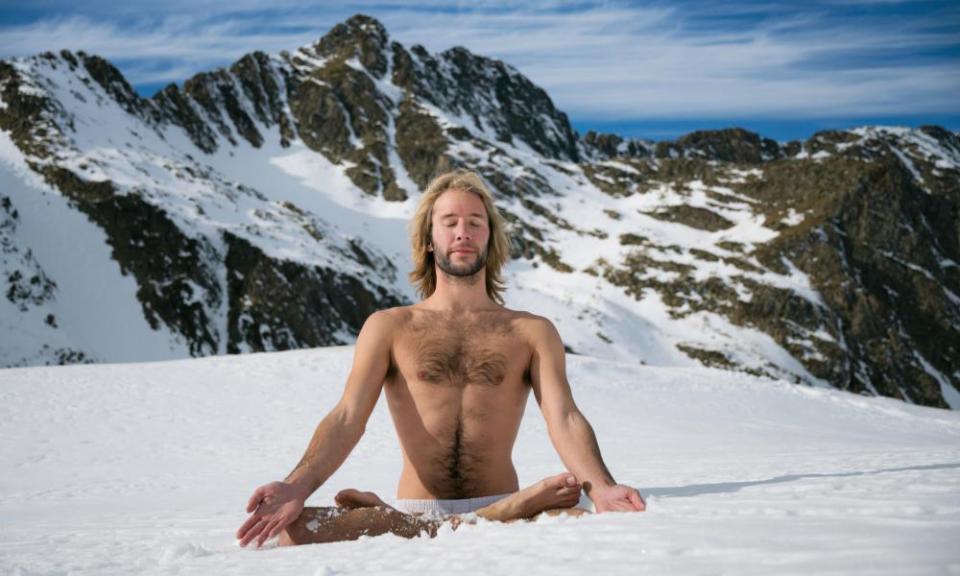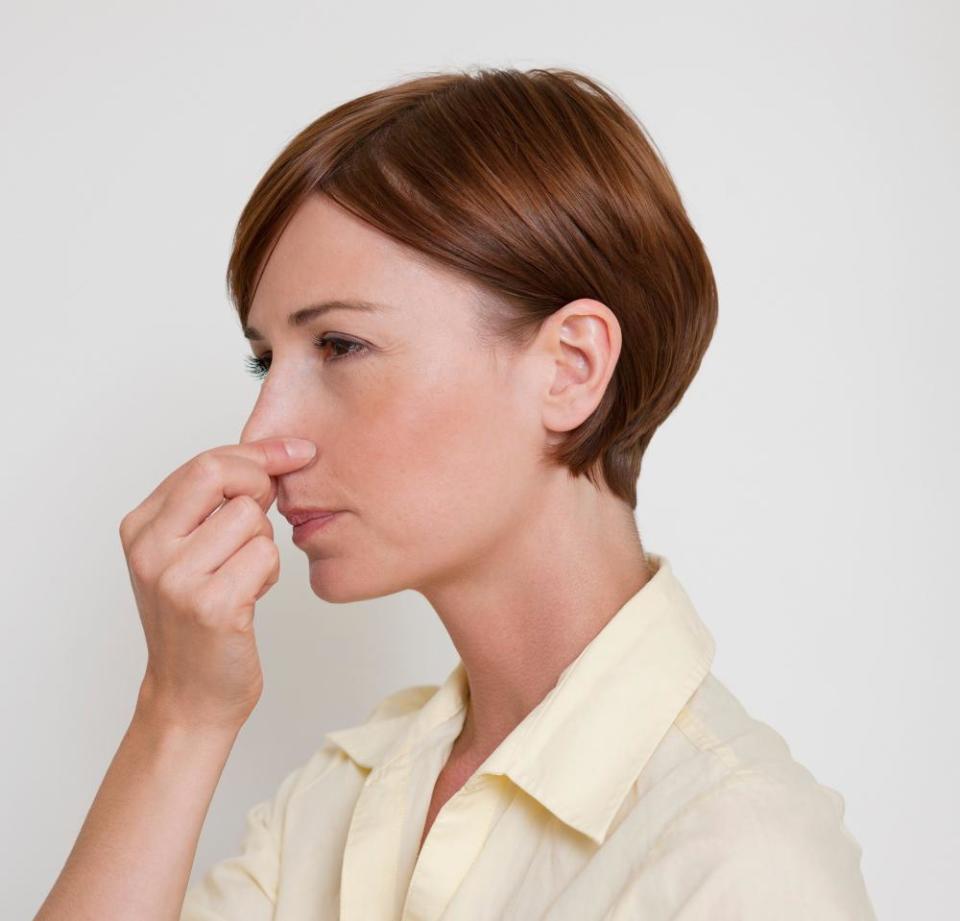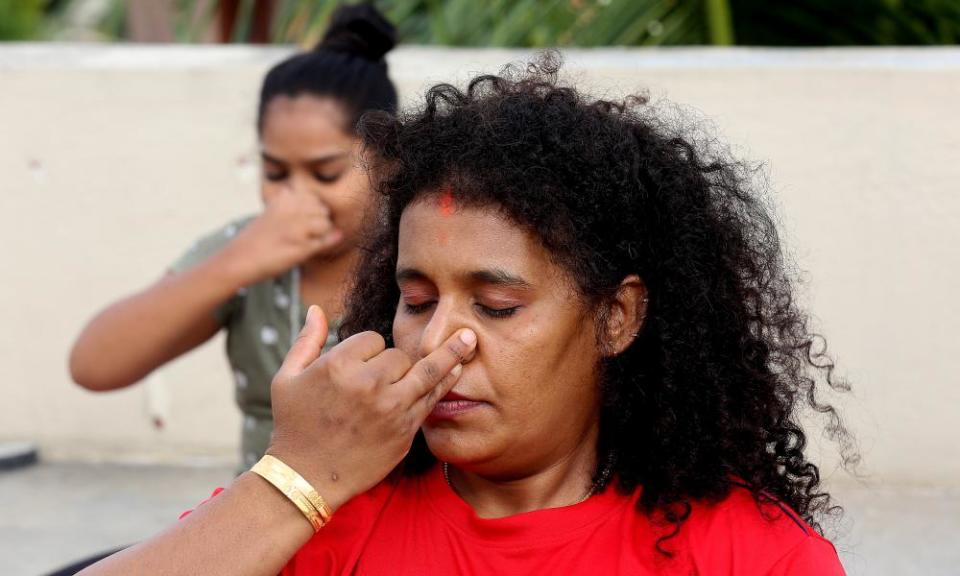Are breathing techniques good for your health?
Alan Dolan couldn’t afford market research when he started out as a breathing instructor in 2005. Instead, he took soundings from London taxi drivers. “I’d tell them I taught people to breathe for a living – they’d be in hysterics and say: ‘What a great scam!’” says Dolan. Recently their reaction has changed: “Now they tell me about their sleep apnoea or their wife’s panic attacks, ask me how that relates to breathing and often download my app.”
Dolan, whose company is called Breathguru, teaches people to breathe deeply from their diaphragm, inhaling for longer than exhaling, without pausing between the two. He says this can, among other things, release stress, alleviate depression, tackle sleep issues, ease respiratory conditions, boost energy and the immune system and eject emotional baggage. Until Covid-19, his retreats in Lanzarote were, he says, fully booked. Such is the level of demand that Dolan has taught 24 trainees to lead sessions like his.
Other “breathwork” practitioners report similar surges in interest, YouTube and Instagram Stories are teeming with breathing courses, and publishers clearly agree it’s a wave worth surfing. Books called Breathe Well, The Power of Breathwork, The Breathing Book and Breathing for Warriors have already been publishedthis year. Still to come in 2020 are Breath: The New Science of a Lost Art, by James Nestor, Exhale, by Richie Bostock, AKA The Breath Guy, and The Wim Hof Method (see box) by Wim Hof.
All of which is a little puzzling to some. Sure, a bit of deep breathing at the end of a yoga class feels good, and many use simple breathing exercises to help them relax. But most people manage their 23,000 or so breaths per day without pause for thought, never mind instruction. So are advocates right that breathwork has a long list of physical and mental health benefits? Or is it just a load of hot air?

There is good-quality evidence to support the use of breathing exercises for asthma. A randomised controlled trial published in 2018 found that quality of life ratings were higher in UK asthma patients who underwent training in deep, slow, nasal and diaphragm breathing. Guidelines used by doctors in the UK state that breathing exercises can help reduce asthma symptoms.
“The evidence is strongest for interventions that involve properly trained physiotherapists,” says Mike Thomas, professor of primary care at the University of Southampton, who led the asthma study. Thomas’s emphasis on registered therapists relates to the use by some of alternative therapies such as the Buteyko method, a controversial technique which includes taping the mouths of people during sleep to train them to breathe through their noses. Adherents say it can treat sleeping disorders, depression, ADHD, chronic fatigue syndrome, asthma and other respiratory conditions.
Patrick McKeown, a Galway-based Buteyko practitioner who advocates mouth-taping during sleep, travels widely to speak at conferences. Prior to Covid-19 he was booked up 18 months in advance. “Five years ago, it was sleep,” he says. “Right now, breathing is hot.” McKeown believes a range of conditions including asthma are caused or exacerbated by a modern human mouth-breathing tendency brought on largely by dietary changes. This, he says, causes excessive oxygen intake, low carbon dioxide levels in the blood, and sub-optimal delivery of oxygen around the body.
It has been suggested that simple breathing exercises can help people with Covid-19
While Prof Thomas acknowledges that more nose-breathing might help some asthma patients, he says the Buteyko method’s emphasis on increased oxygen intake and low carbon dioxide levels in the blood is simplistic. “People with asthma don’t overbreathe, and we’ve measured CO2 levels in asthmatics before and after retraining and found no relationship whatsoever between severity of asthma and CO2 levels,” he says. “The claim that asthma is caused by hyperventilation and low carbon dioxide are scientifically untenable.”
Many of those who turn to breathing exercises do so to deal with stress or anxiety. The NHS website suggests these can be alleviated through short sessions of deep, belly breathing. Scientists have long been interested in studying the effects of practices like yoga and meditation on stress and anxiety; however, there is less research on breathing exercises.

One study found that anxiety levels dropped in a group of Indian medical students who underwent a six-week course of pranayama breathing exercises, while no change was seen in a control group. The pranayama group also saw increases in their heart rate variability (HRV). When we breathe in, our heart beats momentarily faster to speed the flow of oxygen around the body. When we breathe out, our heart slows down. HRV is the difference between these two rates, and higher HRV is seen as a marker of the body’s resilience and flexibility in response to outside stimuli.
A study published in 2017 found that a group of 20 Beijing-based IT workers had lower levels of the stress hormone cortisol in their saliva after undergoing eight weeks of deep, diaphragm breathing sessions – a change not seen in a control group. Italian researchers who reviewed 15 previous studies found slowing breathing promoted short-term increases in HRV, increased comfort and relaxation, and reduced anxiety.
Scientists don’t know precisely how slow, deep-breathing promotes relaxation. However, many believe its ability to increase HRV is key. HRV is controlled by the autonomous nervous system, which regulates subconscious bodily processes including breathing rate and blood pressure. It is subdivided into the sympathetic nervous system, which triggers “fight or flight” responses such as increased heart rate and blood pressure, and the parasympathetic nervous system, which triggers “rest and digest” responses.
Parasympathetic responses are controlled by the vagus nerve, a nervous system superhighway that sends signals back and forth between the brain and different parts of the body. The higher a person’s HRV, the greater the strength of their vagal response to stimuli and the quicker their bodies can activate parasympathetic responses to stress.
When psychologist Roderick Gerritsen, of Leiden University in the Netherlands, reviewed physical and mental health benefits associated with contemplative activities, he concluded that their common focus on breathing reduced stress by increasing parasympathetic nervous system activity. “By slowing the breathing down, your heart rate goes down, you stimulate your vagus nerve, and you’re telling your body it doesn’t have to respond to any immediate threats,” says Gerritsen.
Breathing exercises have been proposed to treat symptoms of many other conditions. Researchers at Augusta University in Georgia, US, suggested that insomnia is largely the result of an evolutionary mismatch between the lifestyles of our caveman ancestors and the “toxic, long-term activation of the sympathetic nervous system” of modern life. They suggest slow, deep breathing can stimulate parasympathetic responses that facilitate both initiating sleep and returning to sleep after night-time waking.
Breathing routines are also used to manage pain. A study involving 48 healthy volunteers published in January found that deep breathing reduced pain caused by heat, especially at rates of about six breaths per minute. Other research linked breathing exercises to reduced heart rates and blood pressure in cardiovascular disease patients.
It has also been suggested that simple breathing exercises can help people with Covid-19. In April, for example, a London doctor recorded a video advising patients to take two sets of five deep breaths held for five seconds followed by a big cough, before lying on their fronts breathing deeply for 10 minutes. The clip was widely shared online. Some patients reported that this helped, however the Association of Chartered Physiotherapists in Respiratory Care said such exercises were unlikely to help those with the dry coughs seen in the majority of Covid-19 sufferers.
There are many animal and short-term laboratory human studies that show breathing slowly and deeply triggers changes in the body linked to healthy outcomes. That, however, is a long way from saying there is solid evidence that breathing exercises can help people change the way they breathe or improve their health in the long term.
Italian physician Luciano Bernardi has shown that breath-control training helped chronic heart failure patients to significantly reduce their breathing rate as well increasing the amount of time they could exercise. “A month after the study the benefits were still present, and we found that most had continued the practice,” says Bernardi. “Like any other training, if you continue to do it you maintain the benefits, and if you stop, after a while, you lose them.”
US researchers found that people with high blood pressure who did daily slow breathing sessions for four weeks exhibited short-term but not long-term reductions in blood pressure. “The problem is that in most human studies any effects of slow, deep breathing seem to be isolated to the lab conditions in which they are measured,” says Don Noble, a physiologist at Emory University, in Atlanta. “Despite some promising results, there haven’t been many well-controlled human studies investigating long-term changes, so the jury is still out.”
It's likely there will be uses for breathing techniques in a variety of medical settings, but it’s not a magic bullet
Mike Thomas, professor of primary care
Current gaps in the scientific evidence base is readily filled by those with books and classes to sell. Extraordinary claims that breathing techniques can treat serious diseases and improve performance in various ways are based on preliminary findings, small studies and research that shows only associations. The claims on Wim Hof’s website, for example, that his method “is linked to reducing symptoms of” diseases including rheumatoid arthritis, multiple sclerosis and Parkinson’s disease are unsupported by high-quality research. Dolan’s website quotes a US doctor as stating: “Possibly one of the best therapies ever discovered for HIV, other infectious diseases, and most degenerative, or chronic illnesses (including cancer) is oxygen therapy.”
Many people undoubtedly benefit from breathing exercises. However, overblown claims about these powers are frustrating for scientists who believe they do have potential for more widespread use, but that this should be supported by good-quality research and trials. “It is likely there will be uses for breathing techniques in a variety of medical settings,” says Thomas. “However, it’s not a magic bullet. “There are a lot of people peddling snake oil. What one has to do is look at these claims with a sceptical eye, and do proper scientific studies to show whether or not it works. If you are just generally worried about your health, it won’t do you any harm. Just don’t expect it to turn your life around.”
Breathing: what’s in and what’s out?

Breathwork is far from new. Yogis, mystics and others have linked disturbed breathing to illnesses and advocated breath control both for health and as part of the path to enlightenment for thousands of years. Breathing-based therapies proliferated in the 60s and 70s. Here are just a few of dozens of different ways to get your oxygen.
Pranayama
Breathing techniques are key to yoga. Breath retentions, alternate nostril breathing, explosive exhales, stretching out the tongue and other techniques are used to calm or invigorate the body, support yoga poses and are considered integral to reaching enlightenment.
4-7-8 breathing
Designed to reduce stress, calm anxiety and help people sleep, it involves inhaling through the nose for four seconds, holding your breath for seven seconds, breathing out through the nose for eight seconds. Yes, there are apps for that.
Holotropic breathwork
A psychotherapy method developed in the 1960s that uses rapid deep breathing, music and physical support to supposedly induce altered states of consciousness as a way to release emotional blockages and heal buried traumas. Considered unsafe for those with cardiovascular disease, high blood pressure and mental health issues.
Butekyo method
A controversial alternative therapy that uses exercises and mouth taping to train people to breathe lightly and nasally. There are GPs who say it can help people, but claims by advocates that many health conditions are the result of chronic over-breathing are not supported by sound scientific evidence.
Wim Hof method
Cycles of controlled hyper-ventilation, extended exhalations and breath-holding, combined with exposure to cold and meditation, designed to trigger positive immune system changes. As seen on the Gwyneth Paltrow Goop Lab series on Netflix.


